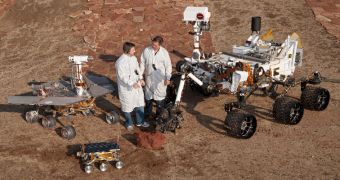Scientists in charge of handling the Mars Science Laboratory (MSL) rover Curiosity say that, if any indicators to the presence of past lifeforms on the surface of the Red Planet exist, the robot will identify them. The team says that the soil is the most likely keeper of such records.
One of the most encouraging things about the upcoming mission is that the MSL will not have to dig very deep to look for potential clues as to the presence of life. The depth of a single scoop of soil should be enough to reveal anything the team is interested in discovering.
Within a few inches of the actual surface, Curiosity will conduct a series of sampling procedures that will either reveal or infirm the existence of the chemistry necessary for the emergence of life. Also, if any bacteria existed on Mars, they left behind detectable clues and traces.
The MSL rover will begin to conduct this class of investigations starting next month, August 6. Once it is commissioned into active duty, the machine will look for signs of organic chemistry underground and inside various geological layers.
Gale Crater, the location selected for the mission to explore first, features a geological structure at its core, called Mount Sharp. The latter was produced by the ejecta plume of a massive asteroid collision, which led to the formation of the crater, Astrobiology Magazine reports.
In a new study, experts at NASA determine the depths and locations where signs of former Martian life are most likely to be discovered. The work was led by Alexander Pavlov, who is a scientist at the NASA Goddard Space Flight Center (GSFC), in Greenbelt, Maryland, and the lead author of the paper.
He believes that the prospects Curiosity has of discovering signs of life on Mars are far better than those of any other mission that came before it. Finding the molecules themselves will not prove that life existed on our neighboring world, but it will demonstrate that it could have, that the stage was set.
Organic molecules could have also been brought to the Red Planet via meteorites and volcanoes, and not necessarily produced by lifeforms. However, this issue remains to be addressed properly when the relevant discoveries are made.
“Right now the challenge is that past Martian landers haven't seen any organic material whatsoever. We know that organic molecules have to be there but we can't find any of them in the soil,” Pavlov says.
Details of the work were published in the July 7 issue of the American Geophysical Union (AGU) journal Geophysical Research Letters.

 14 DAY TRIAL //
14 DAY TRIAL //